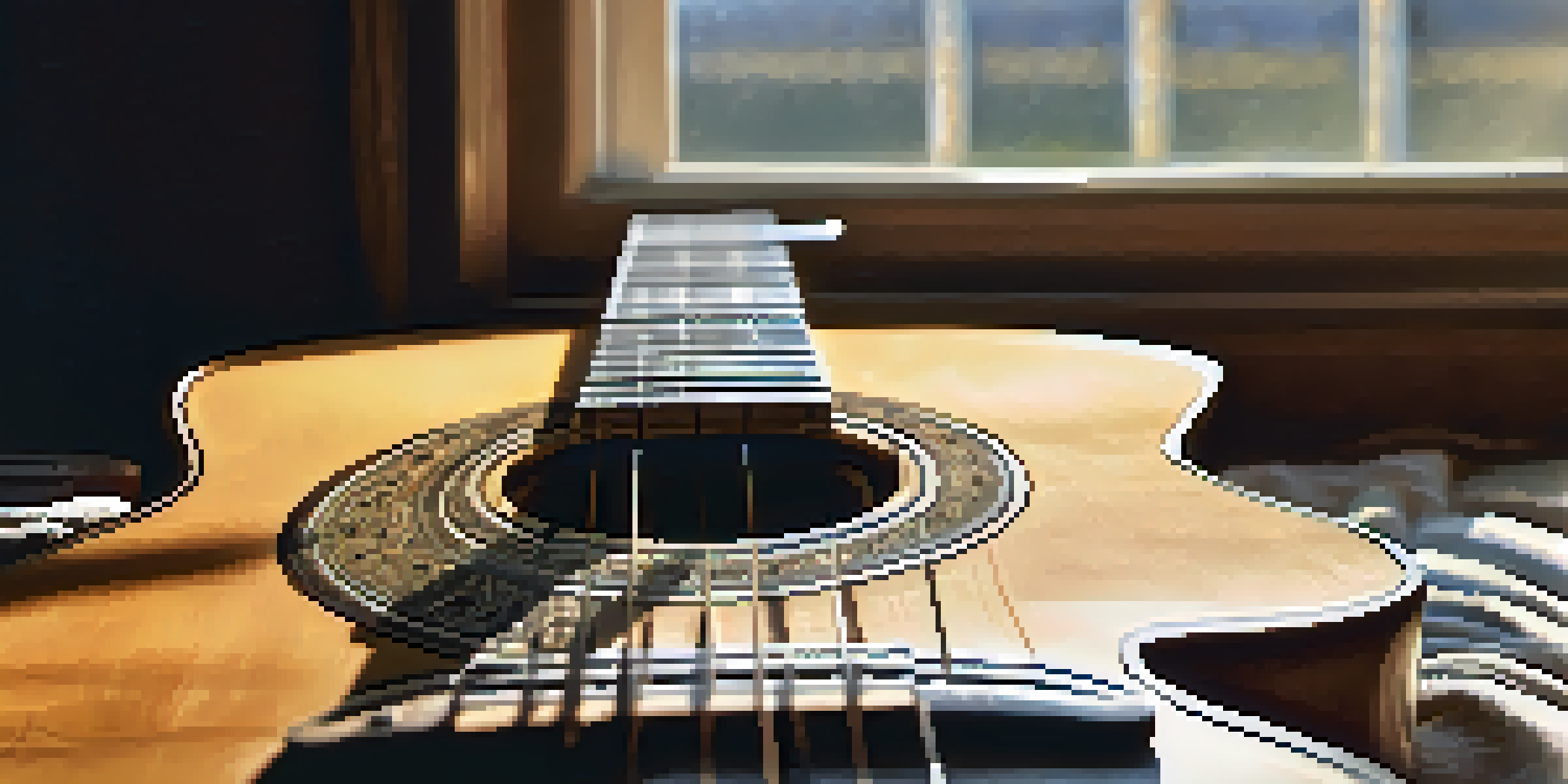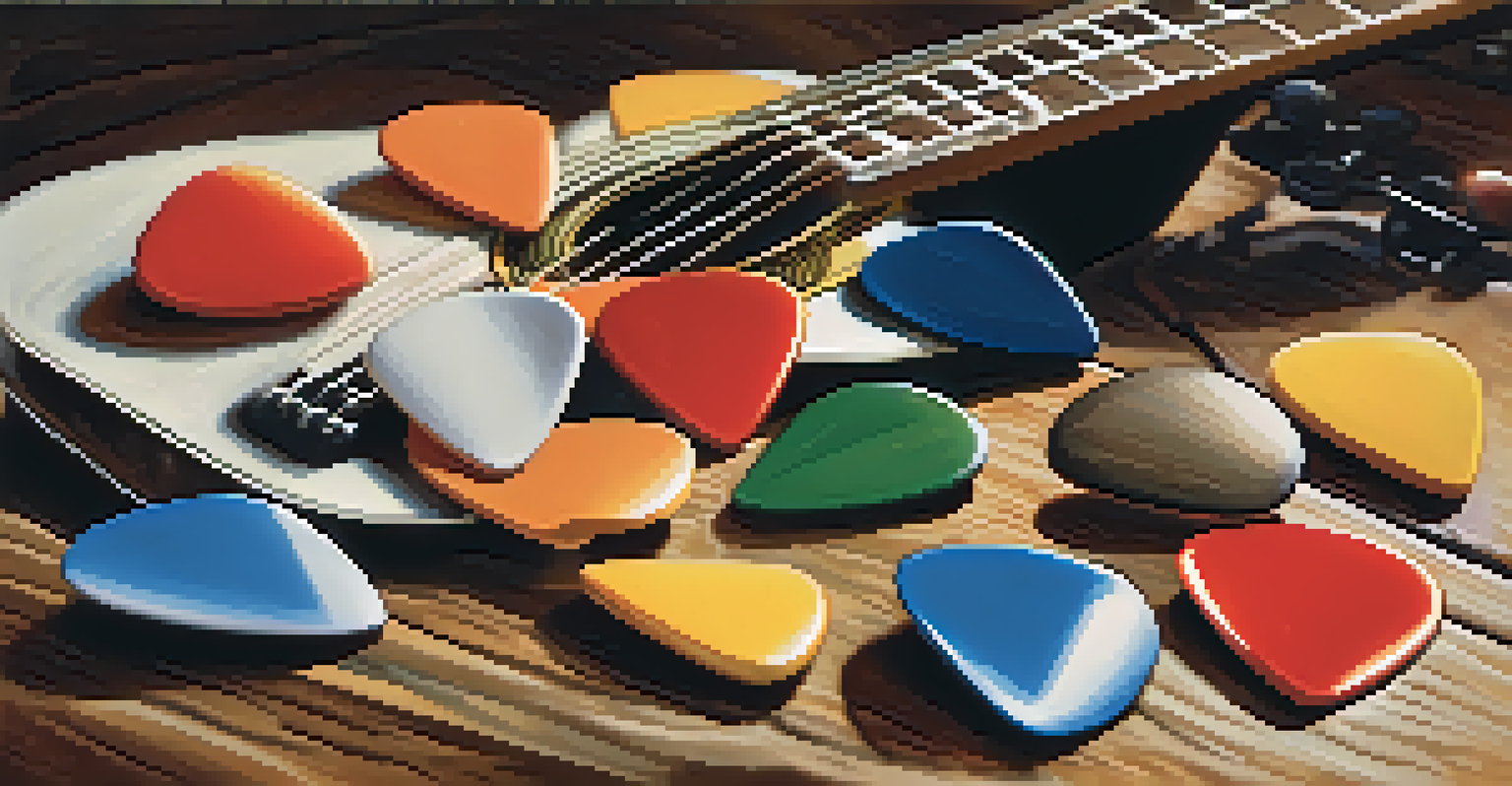Learning to Read Guitar Tabs: A Beginner's Guide

Understanding Guitar Tabs: The Basics You Need
Guitar tabs, or tablature, are a simplified way to read music specifically for guitar. Unlike traditional sheet music, tabs use numbers and lines to indicate which fret to press on which string. This makes it accessible for beginners who might feel intimidated by standard notation.
The beautiful thing about learning is that no one can take it away from you.
Each of the six lines on a tab represents a string on your guitar, with the bottom line being the lowest string (the thickest one). Numbers placed on these lines tell you which fret to press down. For example, a '0' means play the open string, while a '3' means to press down on the third fret.
This format allows you to start playing your favorite songs quickly, as tabs are often available online for countless tracks. Understanding tabs can significantly boost your confidence and get you playing sooner than you might think!
Reading the Layout of Guitar Tabs
To read guitar tabs effectively, it’s essential to familiarize yourself with their layout. Tabs are read from left to right, just like reading text, with each number corresponding to a specific fret on a string. When you see multiple numbers stacked vertically, you should play them at the same time, which indicates a chord.

Additionally, you might encounter symbols that represent techniques like slides, bends, and hammer-ons. For example, a 'h' indicates a hammer-on, while a '/' signifies a slide up. Understanding these symbols will enhance your playing and allow you to incorporate more techniques into your music.
Guitar Tabs Simplify Music Learning
Guitar tabs make it easier for beginners to start playing by using numbers and strings instead of traditional notation.
As you practice reading tabs, you’ll become more comfortable with the layout. It’s much like learning a new language; the more you engage with it, the easier it becomes to understand and translate.
Common Symbols and Their Meanings in Tabs
Guitar tabs use a variety of symbols to represent different playing techniques. Understanding these symbols can significantly improve your playing style and make your music sound richer. For instance, a 'b' indicates a bend, where you push the string up to raise its pitch, while 'p' stands for pull-off, where you pull your finger off the fretboard to play a lower note.
Music can change the world because it can change people.
Other useful symbols include 'x' for a muted strum and 'v' for a vibrato effect, where you slightly wiggle the string after playing a note for added expression. Familiarizing yourself with these symbols will help you interpret tabs more accurately and play your favorite songs as intended.
Taking the time to learn these symbols may seem daunting, but it's akin to adding spices to a dish. Each technique adds flavor to your playing, making it more enjoyable for you and your audience.
Finding Quality Guitar Tabs Online
With the rise of the internet, finding guitar tabs has never been easier. There are numerous websites dedicated to providing tabs for virtually every song you can imagine. Popular sites like Ultimate Guitar and Songsterr offer a vast library of tabs, often including user ratings to help you find the most accurate versions.
When searching for tabs, be discerning about the sources you choose. Some tabs may be incorrect or poorly transcribed, which can lead to frustration in your practice. Look for tabs that have been reviewed or have a high number of likes to ensure you’re learning from the best.
Symbols Enhance Playing Techniques
Understanding symbols in guitar tabs, like bends and slides, adds depth to your playing and helps interpret songs accurately.
Additionally, many of these sites offer lessons and tutorials that can accompany the tabs, providing a more comprehensive learning experience. Utilizing these resources can help you develop your skills and keep your practice sessions engaging.
Tips for Practicing with Guitar Tabs
As a beginner, it’s important to approach practicing guitar tabs with a structured plan. Start by selecting simple songs that you enjoy, as this will keep you motivated and make your practice sessions more enjoyable. Focus on one section at a time, ensuring that you’re comfortable before moving on to the next part.
Using a metronome can also be beneficial to help you maintain a steady tempo. Begin playing at a slow speed and gradually increase it as you become more comfortable with the song. This method allows you to build muscle memory without developing bad habits.
Lastly, don’t hesitate to record yourself while practicing. Listening back can provide valuable insights into areas that need improvement and help you track your progress over time. Remember, patience is key—every great guitarist started where you are now!
The Importance of Ear Training for Guitarists
While learning to read guitar tabs is invaluable, developing your ear for music is equally important. Ear training helps you recognize notes and chords by sound, making it easier to pick out melodies or play by ear. This skill can complement your tab-reading abilities, allowing for greater musical flexibility.
Start by listening to songs and trying to play along without looking at the tabs. This practice can sharpen your listening skills and help you become more attuned to pitch and rhythm. You might be surprised at how quickly you can pick up songs just by ear.
Ear Training Complements Tab Skills
Developing your ear for music is crucial, as it allows you to recognize notes by sound and improves overall musicality.
Incorporating ear training into your routine will not only enhance your playing but also deepen your appreciation for music as a whole. It’s like learning to read the language of music, allowing you to express yourself more freely.
Next Steps: Moving Beyond Tabs
Once you feel comfortable reading guitar tabs, it might be time to explore other areas of music. Learning to read standard sheet music can open up new opportunities and allow you to play a wider variety of genres. While tabs are great for beginners, sheet music provides a more comprehensive understanding of music theory.
Consider enrolling in a music theory class or seeking out online resources to expand your knowledge. Understanding scales, chords, and progressions will enhance your guitar skills and enable you to create your own music.

Ultimately, the journey of learning guitar is ongoing. Embrace the process, stay curious, and keep challenging yourself to grow as a musician. The more you learn, the more fulfilling your musical journey will be.